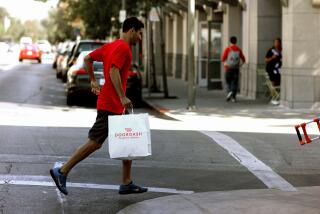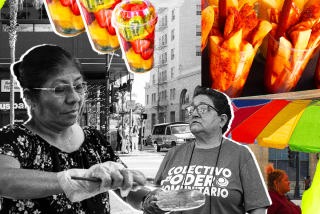This is what it’s like to deliver food during a pandemic

With restaurants’ dining rooms closed, conventional wisdom would suggest that more people are ordering in. And that means better business for app-based food delivery drivers and bike couriers, right?
Wrong, says Justin Zemlyansky, a bike courier who has delivered food on and off for the last three years for delivery platforms such as Grubhub, Caviar and DoorDash.
More people than ever are turning to gigging in the food delivery space, Zemlyansky said. “They’re coming and trying to do these kinds of jobs because it’s the only money and revenue they can get,” he said.
Increased competition aside, Zemlyansky is worried about the coronavirus, which has infected nearly 125,000 people in the United States. Food delivery brings him into contact with dozens of people every day. Zemlyansky is diabetic and immunocompromised, which puts him at even higher risk. For that reason, he said, he bikes — his pants size has gone from a 40 to a 32. Still, he’s concerned for his health and the health of others.
“The pandemic has definitely made things surreal because we’re out here and we’re still contacting people. I’ve delivered to old people and they’re at risk,” he said. “I’m at risk of giving it to them; I’m at risk of getting it. We would be super spreaders if we kept working and we were sick,” which he called a “horrifying thought.”
DoorDash, Instacart, Postmates and Uber have pledged financial assistance to drivers who can’t work because of COVID-19, stating eligible drivers may receive up to two weeks of pay should they contract the disease. But according to a recent Times article, some report that the platforms have unreasonably high standards for meeting the threshold to qualify for financial support. One DoorDash driver said he was suspended from the platform for two weeks after self-reporting symptoms of COVID-19 but was denied benefits because a doctor’s note did not specifically mention the disease. Instacart workers, who demand hazard pay and safety equipment, will hold a nationwide strike Monday.
A typical day will see Zemlyansky out from 10 a.m. until 10 p.m. There are big lunch and dinner rushes, with slow times in between. On a busy day, he’ll get as many as 30 orders and can make $220. On slow days, as he’s been having lately, it can be only 10 to 12 orders a day. During the 90 minutes in which he and I spoke, his apps were on but he received no orders.
“You would think people are ordering more, but they’re not,” he said. “Everybody went and stocked up on groceries. People are at home, they’re cooking or watching YouTube and learning how to cook. And people are worried about their finances right now. They’re not trying to order food.”
The other problem, he said, is that customers “actually haven’t been tipping better.”
“A lot of people don’t tip; that’s a thing,” he said. But delivery drivers rely on tips to make a living wage. “Unfortunately, we live in a tips-based culture. So if you’re not tipping, I’m making $2, $3 an order sometimes.”
Last year, both Grubhub and DoorDash changed their pay structures. In August, DoorDash announced it would adopt a new pay model in response to outrage regarding its old policy, in which drivers received a guaranteed minimum but did not keep 100% of their tips.
The problem, Zemlyansky said, is that he earns less money under the new system. He used to be able to count on a certain hourly minimum. Now it varies greatly from day to day. The result is more work for less money. “I could make $1,200 a week working six days a week,” he said of his income before the switch. Now, he struggles to make $800 a week while working more hours.
He said he empathizes with people’s need to save money during this time but called upon the platforms to do more for its workers. “Not everybody’s willing to work for $2 or $3 an order,” he said. “You guys need to pay us better.”
But Zemlyansky, who bikes with a spare inner tube in case of a flat and a plastic baggie full of small tools, emphasized the difficulty of the job. “It is physically demanding,” he said. “This is manual labor.”
More to Read
Eat your way across L.A.
Get our weekly Tasting Notes newsletter for reviews, news and more.
You may occasionally receive promotional content from the Los Angeles Times.







